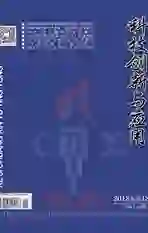三维狄拉克半金属的古斯—汉欣效应研究
2018-06-28王国飞
王国飞
摘 要: 用有限元软件Comsol Multiphysics进行模拟仿真,研究了线偏振光入射到三维狄拉克半金属的古斯-汉欣效应。结果表明,对于TE/TM偏振入射光,随着波长增大,古斯-汉欣位移均达极值,不同偏振光的古斯-汉欣位移方向相反。
关键词: 三维狄拉克半金属;古斯-汉欣效应;有限元模拟
中图分类号:TB383 文献标志码:A 文章编号:2095-2945(2018)18-0005-03
Abstract: Applying the finite element software Comsol Multiphysics to finite element simulation, this paper studies the Goos-Hnchen (GH) effect of linear polarized light incident to 3D Dirac semi-metal. The results show that for the polarized incident light of TE/TM, with the increase of wavelength, the displacement of Goos-Hnchen reaches an extreme value, and the direction of the shift of Goos-Hnchen of different polarized light is opposite.
Keywords: 3D Dirac semi-metal; Goos-Hnchen effect; finite element simulation
引言
光束入射到两种不同介质的分界面,反射光束偏离几何光学的预期并产生了位移,该位移被称为古斯-汉欣(GH)位移[1]。GH位移的研究涉及不同的材料,如金屬[2],电介质[3],超材料[4,5],二维材料石墨烯[6],拓扑绝缘体[7];也扩展到了不同的领域,如波导中的位移增强[8,9],光束平移与控制[10]等。
近来,三维狄拉克半金属(3D DSM)这种量子拓扑材料日益受到人们的重视。中科院方忠、戴希小组理论首次预言A3Bi(A=Na,K,Rb)为3D DSM[11],随后Na3Bi第一个被实验证实[12]。接着人们利用角度分辨的光电子能谱研究了其他3D DSM,如Cd3As2[13]并测量了Cd3As2[13]的光电导。但是,截至目前3D DSM的GH效应尚未得到关注。
本文研究线性偏振光入射到3D DSM平板后发生的GH效应,通过改变不同入射光波长来研究三维狄拉克半金属的古斯-汉欣位移的变化情况。
1 仿真建模
1.1 理论模型
如图1所示,波矢为k的入射光以?兹角度入射到放置于空气中的狄拉克半金属层上,反射光产生了一个向右的位移Dr,其中n和d分别表示3D DSM层的折射率和厚度。空气的有效折射率设置为1,三维狄拉克半金属材料的介电函数则由Drude模型计算[14]:
式中?着b为有效背景介电常数,g为简并因子,?着c为约化截止能量,?滋F表示三维狄拉克半金属的化学势或费米能。
1.2 建立仿真模型
统一设置三维狄拉克半金属的厚度为2?滋m,入射光为TE/TM偏振光,从左侧以45°入射角入射,波长变化范围在2?滋m到12?滋m之间。如图2所示,左上角梯形区域和右下角三角形区域为空气域,斜条A区域为三维狄拉克半金属层。在端口E0 /H0的z分量中设置高斯光束表达式为:
(2)
其中光束腰宽w=5?姿,频率的大小f=c/?姿。
2 结果与讨论
图3(a)和图3(b)中分别展示了TM(?姿=8.554?滋m)和TE(?姿=8.119?滋m)偏振光以入射角45°入射时产生的古斯-汉欣位移。图3(a)中可以发现GH位移较小,且位移方向为正向;而(b)图中GH位移较大且位移方向为负。为了更好地研究变化的波长对于古斯-汉欣位移的影响,从波长范围2?滋m<?姿<12?滋m内取若干点,观察TM/TE偏振入射光的古斯-汉欣位移。
如图4(a)所示,TM光入射下GH位移在4<?姿<55?滋m时几乎为0,GH位移随波长的增加平缓变化且大部分情况下Dr>0。在?姿=7.26?滋m处有最小值,且Dr<0,在?姿<8.554?滋m处获得最大值,当?姿>9.2?滋m时GH位移变化趋于平缓且Dr>0,总体反射光光束趋于正向偏移。图4(b)是TE偏振光入射下GH位移随波长变化关系图。从图中我们可以发现GH位移在0<?姿<6?滋m时几乎为0;而在6<?姿<8.5?滋m时,GH位移Dr<0且变化剧烈,在?姿=8.119?滋m处获得最小值;在?姿>9.5?滋m时,GH位移缓慢变小且此时Dr>0。相比TM入射,TE入射条件下古斯-汉欣的位移幅度更大更易于观察。
3 结束语
本文利用了有限元方法,探究了波长对于三维狄拉克半金属材料的古斯-汉欣位移的影响。改变入射光波长大小,对于TM/TE入射光,当波长0<?姿<6?滋m时,二者的古斯-汉欣位移都很小。当波长6<?姿<9?滋m时,TM偏振光下的古斯-汉欣位移都较大,正负方向分别取得极值,正向位移占主体;而TE偏振光的古斯-汉欣位移负向较大。波长大于9?滋m后,两种偏振的古斯-汉欣位移方向都为正且位移大小Dr慢慢变小并趋于0。
参考文献:
[1]Goos F and H Hnchen, Ein neuer und fundamentaler Versuch zur Totalreflexion [J]. Annalen der Physik,1947,436(7-8):333-346.
[2]Merano M, Aiello A, Hooft G W, et al., Observation of Goos-Hnchen shifts in metallic reflection [J]. Optical Express, 2007,15(24):15928-15934.
[3]Li C-F, Negative Lateral Shift of a Light Beam Transmitted through a Dielectric Slab and Interaction of Boundary Effects [J]. Physical Review Letters,2003,91(13):133903.
[4]Yu W J, Sun H, and Gao L, Enhanced normal-incidence Goos-Hnchen effects induced by magnetic surface plasmons in magneto-optical metamaterials [J].Optical Express,2018,26(4): 3956-3973.
[5]Wang C, Wang F, Liang R, et al., Electrically tunable Goos-Hnchen shifts in weakly absorbing epsilon-near-zero slab [J].Optical Material Express,2018,8(4):718-726.
[6]Chen S, Mi C, Cai L, et al., Observation of the Goos-Hnchen shift in graphene via weak measurements[J].Applied Physics Letters,2017,110(3):031105.
[7]Liu F, Xu J, Song G, et al., Goos-Hnchen and Imbert-Fedorov shifts at the interface of ordinary dielectric and topological insulator [J].Journal of the Optical Society of America B,2013,30 (5):1167-1172.
[8]Xuan-Bin L, Zhuang-Qi C, Peng-Fei Z, et al. Simultaneously large and opposite lateral beam shifts for TE and TM modes on a double metal-cladding slab[J]. Chinese Physics Letters, 2006,23(8):2077.
[9]Chen L, Cao Z, Ou F, et al. Observation of large positive and negative lateral shifts of a reflected beam from symmetrical metal-cladding waveguides[J].Optics letters,2007,32(11):1432-1434.
[10]M. Peccianti,A. Dyadyusha,M. Kaczmarek,G. Assanto."Tunable refraction and refection of self-confined light beams". Nature Physics,2006.
[11]Wang Z, Sun Y, Chen X-Q, et al., Dirac semimetal and topological phase transitions in [J]. Physical Review B,2012,85 (19):195320.
[12]Liu Z K, Zhou B, Zhang Y, et al., Discovery of a Three-Dimensional Topological Dirac Semimetal[J].Science,2014,343 (6173):864-867.
[13]Neubauer D, Carbotte J P, Nateprov A A, et al., Interband optical conductivity of the [001]-oriented Dirac semimetal [J]. Physical Review B, 2016, 93 (12): 121202.
[14]Kotov O V and Lozovik Y E, Dielectric response and novel electromagnetic modes in three-dimensional Dirac semimetal films [J].Physical Review B,2016,93(23):235417.
